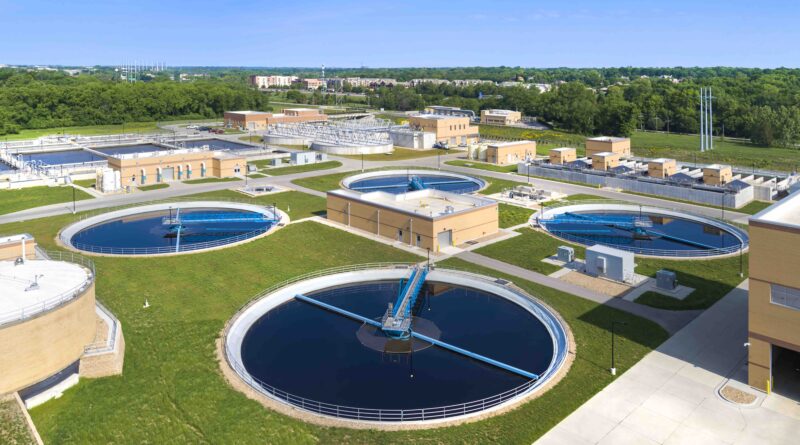Multi-Million Dollar Expansion Project in the Midwest
One particular Kansas wastewater treatment facility underwent vast improvements after increased flow had proven too much for the original design
By Brian Alvarado
Originally constructed in 1955, the Tomahawk Creek Wastewater Facility in Leawood, Kansas serves parts of Leawood, Overland Park, Olathe and Prairie Village in the Sunflower State. Over time, population growth in the area had caused an uptick in flow to the facility. The original plan to deal with the increase was to send about 60% of the incoming flow to Kansas City, Missouri while treating the remaining 40%. However, project makers decided that the best course of action was to upgrade and expand.
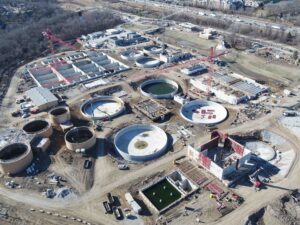
The development team had three goals with this project. The first was to meet the water quality standards set by the U.S. Environmental Protection Agency (EPA) and the Kansas Department of Health and Environment (KDHE) that require stricter limits on discharge for things such as ammonia, nitrogen and phosphorus. Second was to upgrade the assets at the facility that were at the end of their useful life. The final goal was to expand the facility to treat all the received flow to minimize future operating and maintenance expenses.
“The expansion and upgrade of the Tomahawk Creek Wastewater Treatment Facility (WWTF) is the largest project ever undertaken by Johnson County,” said Susan Pekarek, general manager of Johnson County Wastewater (JCW).
Johnson County Wastewater is the owner and operator of the Tomahawk Creek WWTF. JCW contracted with Black & Veatch who partnered with HDR for project definition, design and construction phase services. For preconstruction services and construction services, JCW called on McCarthy Building Companies as the Construction Manager at Risk (CMAR). Both teams were selected through separate requests for proposal processes.
One of the biggest design issues the team encountered was the initial cost estimate, which was calculated to be $60 million over JCW’s budget.
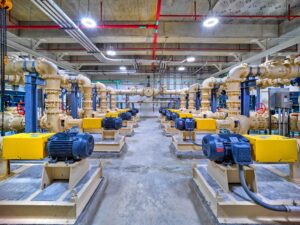
Collaboration and utilization of the CMAR delivery method to develop innovative, cost-saving options enabled the project team to conduct a thorough value engineering review. This helped accelerate redesign changes in just six weeks to keep the project on schedule for construction groundbreaking in April 2018.
Mother nature had also taken its toll on the upgrade project, as the project team had to navigate through the wettest year on record in the Kansas region. Per JCW, there was more than 64 inches of rain from October 2018 to October 2019.
“The entire site was raised using fill to bring the facilities out of the floodplain. An overflow channel was constructed to serve as a relief point for Indian Creek floodwaters and to avoid any additional flooding to surrounding properties,” said JCW Assistant Chief Engineer and Integrated Planning Manager Tami Lorenzen.
One of the highlighted features of the project is the Dual-Purpose Filtration system, which is the largest disk filtration system in the world, per JCW.
“This filtration system acts as a final polishing filtration system during normal flows, but also serves as a wet weather auxiliary treatment system during major storm events,” said JCW Managing Treatment Engineer Alex Szerwinski. “This allows us to treat the higher wet weather flows on site instead of pumping them to a storage facility that would have been large, costly and disruptive to the community.”
Via partnerships with its designers, the EPA and KDHE, JCW was able to permit this filter system and avoid the cost of roughly $200 million dollars for storage.
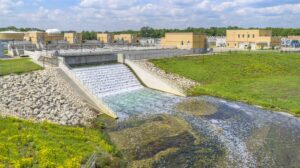
JCW puts an emphasis on sustainability in its projects. Aside from the reduction of nitrogen and phosphorus in its treated water, the Tomahawk WWTF development team also reused trickling filter rock and concrete from the original facility to aid in site navigation during wet construction conditions.
“Being an environmentally focused organization, efficiently using resources is a big part of what we do,” said Szerwinski.
The project was substantially completed in March 2022, about seven years from the initial project definition. Since then, the Tomahawk Creek WWTF project has received numerous honors.
In particular, the concrete work on the project was awarded the 2020 Judges Award by the American Concrete Institute and the 2020 Excellence in Concrete Award for Wastewater from the Concrete Promotional Group.
JCW was also included in the Mid-America Regional Council’s 2022 Resilient Success Stories. The organization was honored for the beneficial impact of the Tomahawk Creek WWTF’s sidestream treatment process, which helps decrease energy consumption to help the facility meet environmental
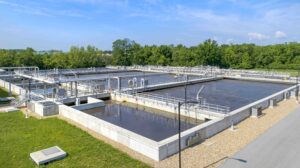
requirements and reduce costs.
This year, the project was selected as one of the Capstone Award winners from the Kansas City Business Journal and the Grand Prize for Design in the American Academy of Environmental Engineers E3S (Excellence in Environmental Engineering and Science) Awards.
“The successful completion of this project started with the vision and planning of JCW’s leadership team with support from the Board of County Commissioners who understood this vital community need,” said Szerwinski. “These projects do not happen overnight. It took thousands of people from different backgrounds in operations, engineering and construction over the course of multiple years to see this project through from concept to reality.”
Brian Alvarado is senior editor at large for American Infrastructure.

